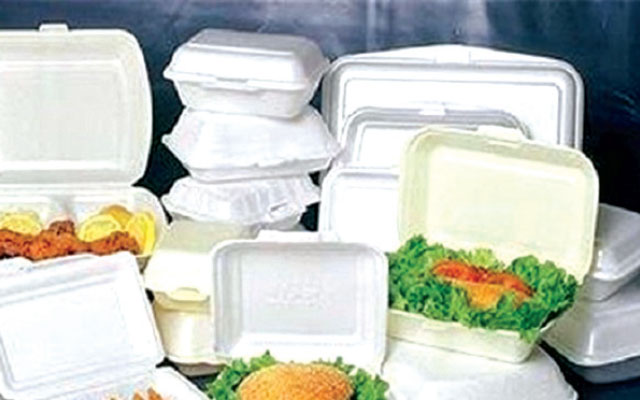Kaylites: Campaigners cheer ban. . . as EMA rapped for knee-jerk reaction

Jeffrey Gogo Climate Story
On July 13 the Environmental Management Agency (EMA) announced a seemingly impromptu ban in the use of polystrene-based packaging, the famous kaylite, sparking an uproar from businesses and food vendors that use the packaging to serve their customers.
Campaigners have broadly cheered the ban saying it is a victory for the environment.
“I think the ban is a very good thing,” Charlene Hewat, a respected environmentalist, told The Herald Business Friday, by phone.
“Kaylite is detrimental to the environment, and can be very difficult to bio-degrade,” she added.
Food-related waste from industry and commerce reached nearly 150 000 tonnes per year countrywide in 2011, according to a 2015 solid waste report by EMA. Kaylite makes up a key component of this waste.
And with over 48 percent of Zimbabwe’s 614 000 tonnes of total urban solid waste each year either burnt, buried underground or dumped anywhere, according to EMA figures, garbage is already a nightmare for environmental authorities.
Uncollected solid waste is usually a key contributor to flooding in cities and towns, and to air and water pollution. Such waste tends to clog waterways and canals, flooding streets and homes.
Now, EMA has tried to bring order in the (mis)use of a popular packaging product that it has branded an environmental nuisance, one threatening public health, officials say.
But even Ms Hewat is disappointed at the manner the kaylite ban has come into force, appearing to surprise an uniformed and unprepared market.
“I do not think there has been enough consulation made with the relevant stakeholders, including retailers, manufacturers and the informal sector, which is a huge consumer of kaylite,” lamented Ms Hewat, who is also chief executive at Environment Africa, a civic environmental organisation.
“I am an environmentalist, and I didn’t even know there was a ban coming.
“This is the first time I’ve had about it, and I heard about it through a newspaper report. I am shocked.”
Hewat questioned the process that led to the implementation of the ban.
“As an organisation we are for the ban. However, what are the implications? Does this mean some factories are going to close?
“Are people going to lose their jobs? We do not know all of that,” she quipped.
What surprise?
The Environmental Management Agency in 2012 passed a law banning the use of kaylite, as packaging material in supermarkets, restaurants and in fast food shops.
Those that cook food on the streets and in other corners of the flourishing informal industry were also prohibited from using kaylite.
But despite the ban, that law – Statutory Instrument 84 of 2012 – had not been enforced until last Thursday.
That’s because EMA “gave a grace period” of four years to users of polystrene-based packaging to switch to alternatives, preferably paper (card-board), which degrades easily and is recyclable.
The “grace period” expired on June 1, 2016, EMA says on its website.
“Kaylite constitute a form of packaging that is a menace to the environment,” said a source at EMA, who preferred anonymity.
“We do not understand why business is crying foul. They have had enough time to change over to other packaging options.
“This is, in fact, a business opportunity for manufacturers of packaging products.”
As Confederation of Zimbabwe Retailers president Denford Mutashu protested the ban’s lack of consultation, EMA had by Friday already hit the ground running, dispatching a team of inspectors to businesses manufacturing kaylite to enforce the ban, sources said. It is important to note that the ban does not extend to cover other polystrene-based packaging items such as cooler boxes, cistern floats, swimming floats, roof insulation and others.
So, it is a ban restricted to the food industry alone, officials said.
Waste nightmare
Polystyrene foam is formed by adding a blowing agent to polystyrene, a petroleum based plastic material, according to experts at EMA.
The foam is light, cheap and with good insulation properties, making it a favourite for businesses.
It can be used in all types of products from cups that keep beverages hot or cold to materials that protect items during shipping without adding weight, the experts say.
However, kaylite has emerged as one of the greatest, complex environmental concerns in cities and towns.
Because kaylite does not decay, it can be present in the environment for several decades, making that makes it harmful to nature both on land and in water.
EMA says kaylite production is responsible for the production of climate changing gases, especially hydroflourocarbons (HFCS).
“There are potential health impacts from polystyrene foam food packaging associated with its production and with the leaching of some of its chemical components into food and drink,” the regulator contends.
“The general public is not typically warned of these public hazards,” it adds.
Overall, solid waste management still remains a nightmare in Zimbabwe.
According to a 2015 World Bank report, ‘What a Waste’, Zimbabweans in towns and cities produced an average 2 356 tonnes of garbage every day or 859 940 per year- enough waste to fill the entire surface area of seven football pitches.
The figure is expected to more than double to 5 277 tonnes by 2025, the bank says, as urbanisation and economic development grow steadily.
Over 7,5 million people will be staying in towns and cities here within the next decade, compared to the current 4,4 million, said the report.
On a per capita basis, Zimbabweans generate 0,53 kilogramme of trash per household each day, in line with much of Africa.
Much of the waste is collected and disposed in landfills, dumpsites, recycled or is dumped illegally.
However, the whole process produces greenhouse gases at every stage – from the carbon generated by vehicles collecting garbage to the methane generated at landfills and dumpsites.
In 2000, the waste sector accounted for 16 percent of national methane emissions, or 417 gigatonnes of methane emissions, Government data shows.
God is faithful.












Comments